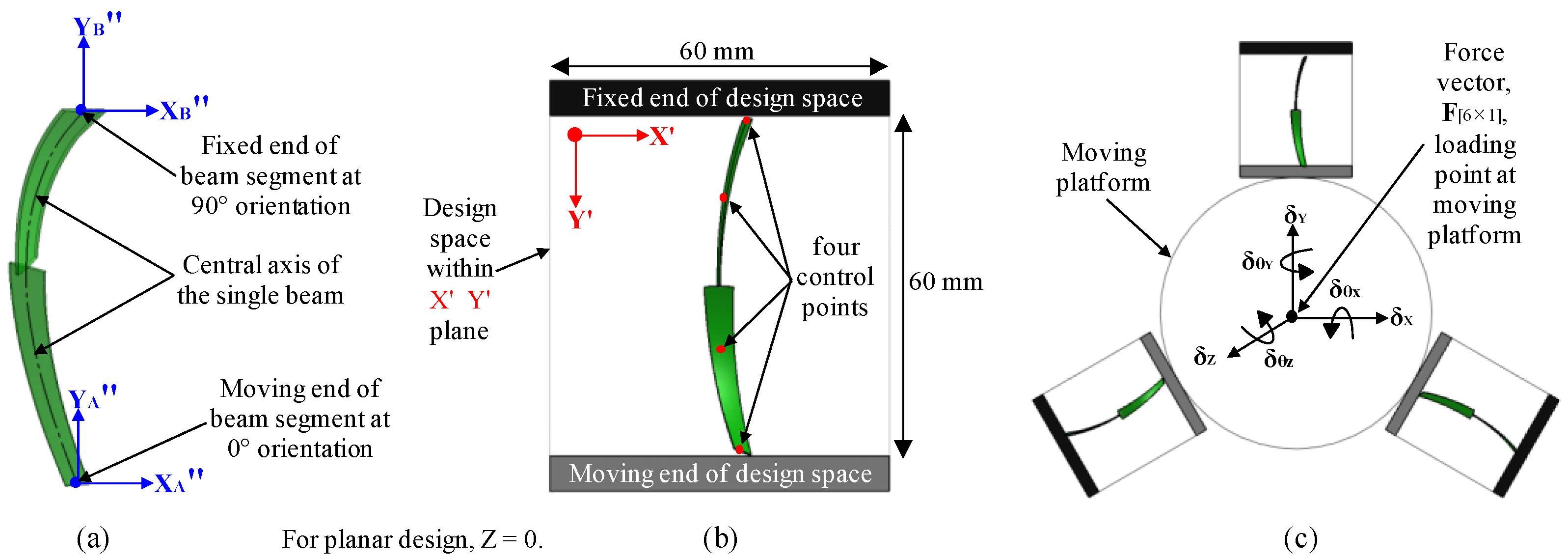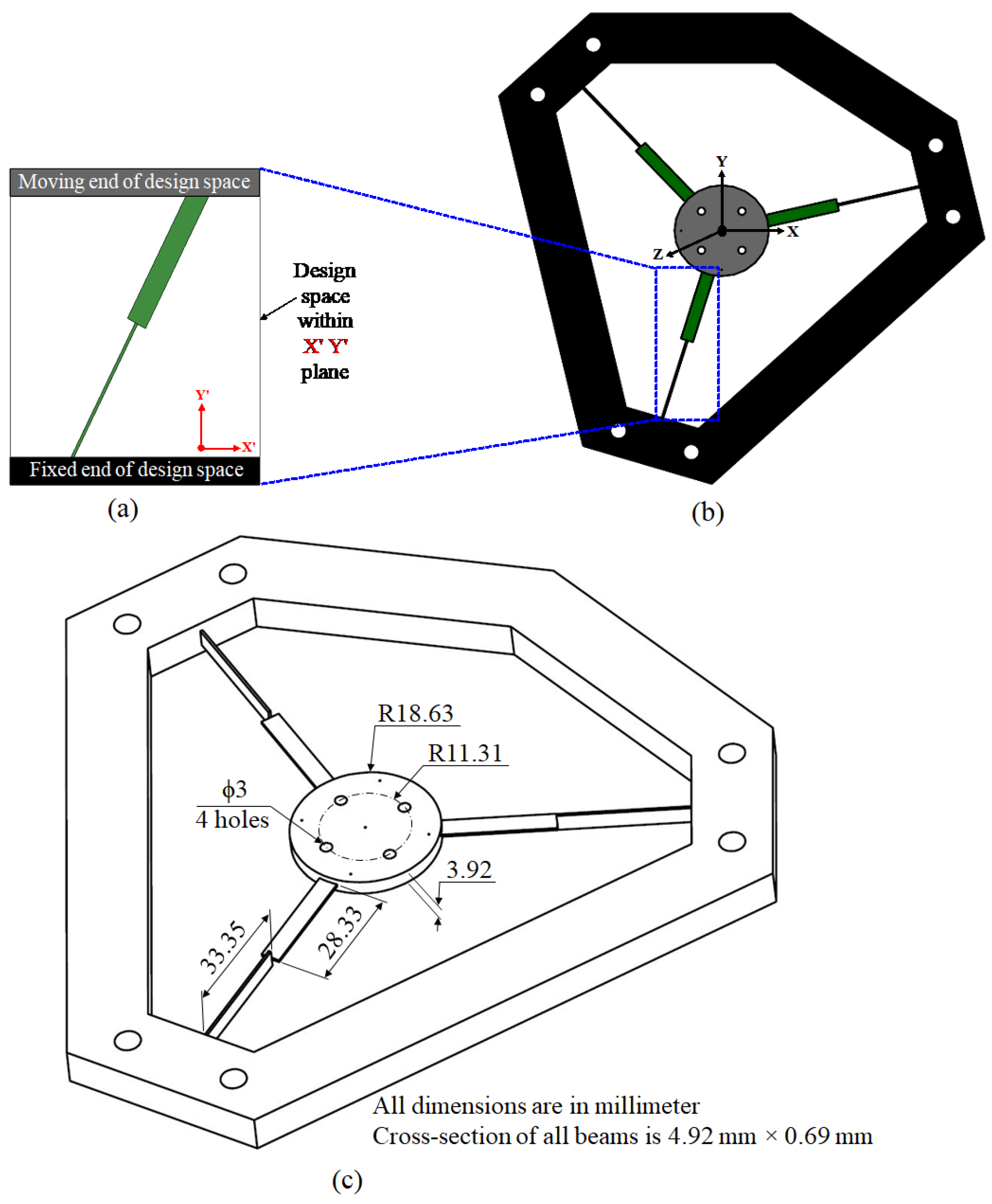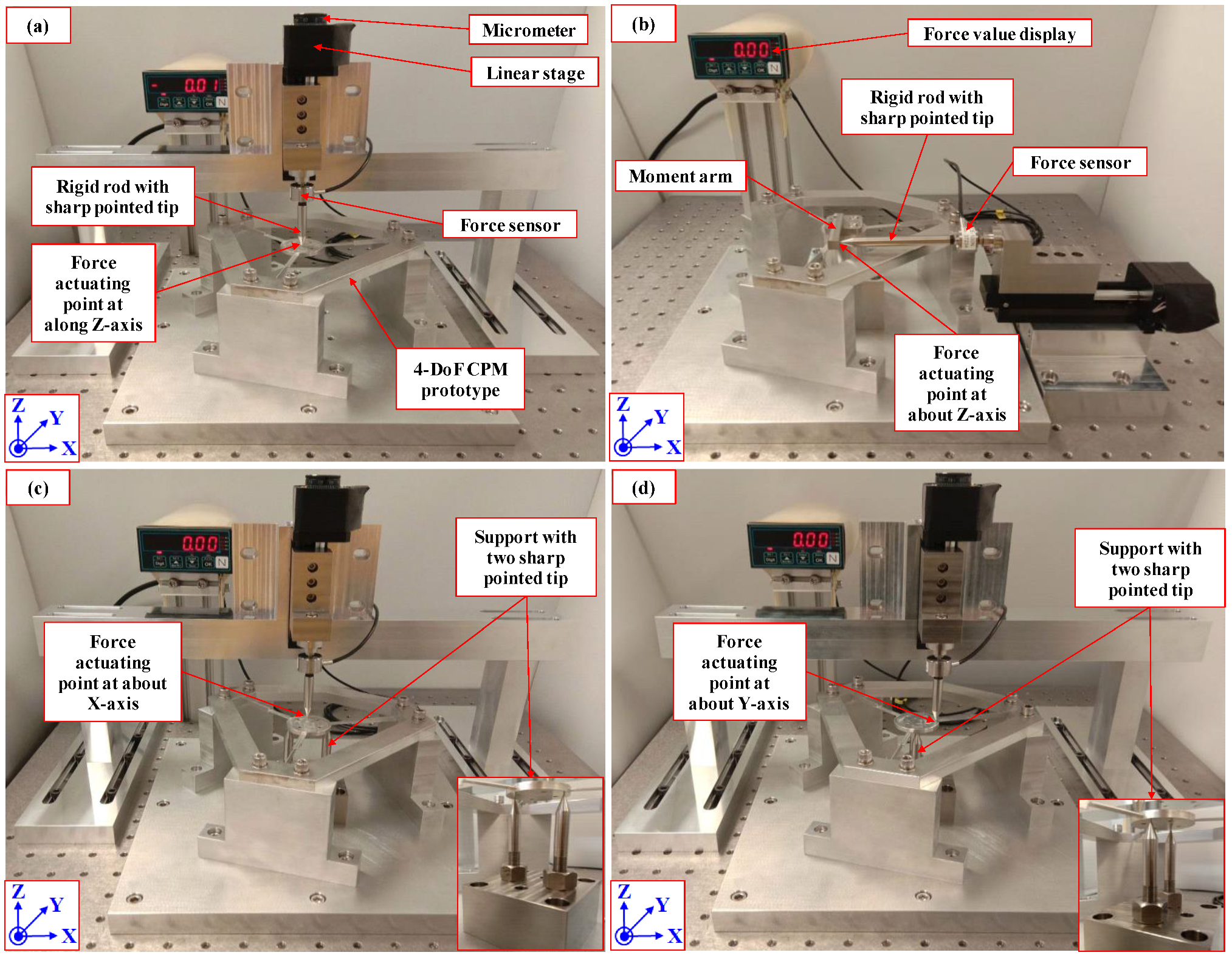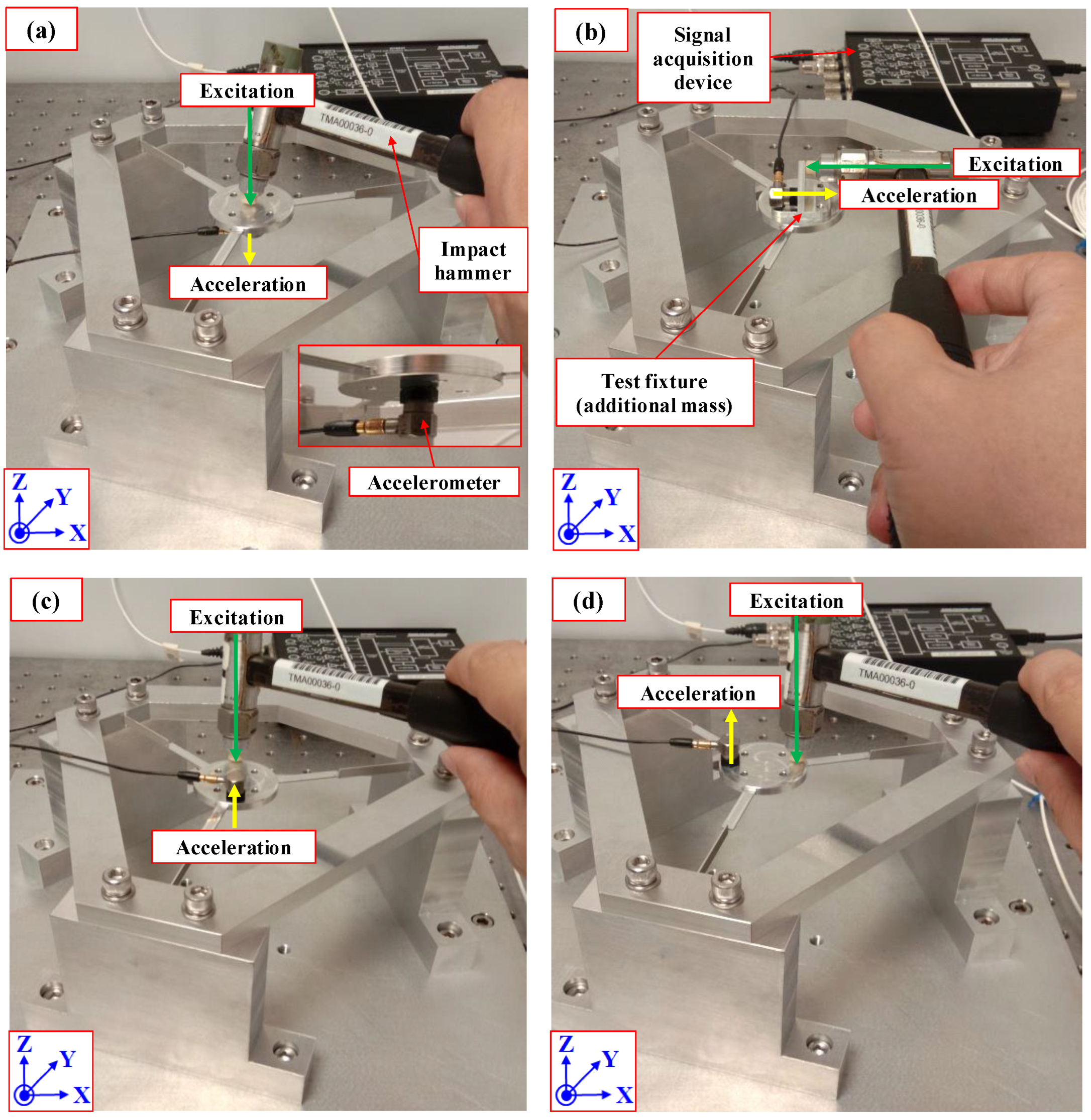Synthesis of Compliant Parallel Mechanisms Using an Improved Beam-Based Method with the Optimization of Multiple Resonant Modes
Abstract
1. Introduction
2. Design Methodology
2.1. Beam-Based Method
2.2. Improved Beam-Based Method with Optimization of Multiple Resonant Modes
2.3. Mathematical Formulation
2.3.1. Objective Function for Stiffness Optimization
2.3.2. Objective Function for Optimization of Multiple Resonant Modes
2.4. Synthesis of a 4-DoF (Z-θX-θY-θZ) CPM
2.4.1. Stiffness Optimization
2.4.2. Dynamic Optimization of Multiple Resonant Modes
2.4.3. Discussion of the Optimized Results
2.4.4. Formulation of the Pseudo-Rigid Body Model (PRBM)
3. Experimental Investigation of a 4-DoF CPM Prototype
3.1. Fabrication and Compensation of the Prototype
3.2. Experiments to Evaluate the Compliance of the Prototype
3.3. Experiments to Evaluate the Dynamic Response of the Prototype
4. Discussion
5. Conclusions
Author Contributions
Funding
Data Availability Statement
Acknowledgments
Conflicts of Interest
Abbreviation
| Notations | Meaning | Equation That the Notations Appear |
| δ/δ | Displacement vector/displacement component | (3), (4), (5) |
| γ | Characteristic radius | (17) |
| ω | Angular frequency vector | (10) |
| C/C | 6 × 6 compliance matrix of the CPM/diagonal compliance component of the CPM | (3), (16) |
| 6 × 6 compliance matrix after dynamic optimization | (15) | |
| 6 × 6 compliance matrix after stiffness optimization | (13) | |
| F/F | Force vector/force component | (3), (4), (5) |
| f | Resonant frequency vector | (10) |
| Objective function for dynamic optimization | (11), (14) | |
| Objective function for stiffness optimization | (8), (12) | |
| Targeted resonant frequency | (11), (14) | |
| K/K | 6 × 6 stiffness matrix of the CPM/diagonal stiffness component of the CPM | (2), (4), (5), (12), (16) |
| 12 × 12 stiffness matrix of a 2-noded beam element | (1) | |
| Full stiffness matrix of the entire CPM | (1), (2), (10) | |
| KA | Stiffness of the linear spring | (17) |
| KT | Stiffness of the torsion spring | (17) |
| Kθ | Bending stiffness coefficient | (17) |
| L/ΔL | Original beam length/change of length | (17) |
| 12 × 12 mass matrix of a 2-noded beam element | (9) | |
| Full mass matrix of the entire CPM | (9), (10) | |
| RE | Total elastic energy ratio | (7) |
| U | Strain energy of the CPM | (4), (5), (7) |
References
- Zhan, W.; He, X.; Yang, J.; Lai, J.; Zhu, D. Optimal design method for 3-DOF planar compliant mechanisms based on mapping matrix constraints. Structures 2020, 26, 1–5. [Google Scholar] [CrossRef]
- Hao, G. Towards the design of monolithic decoupled XYZ compliant parallel mechanisms for multi-function applications. Mech. Sci. 2013, 4, 291–302. [Google Scholar] [CrossRef]
- Ling, M.; Cao, J.; Howell, L.L.; Zeng, M. Kinetostatic modeling of complex compliant mechanisms with serial-parallel substructures: A semi-analytical matrix displacement method. Mech. Mach. Theory 2018, 125, 169. [Google Scholar] [CrossRef]
- Zhang, Y.; Su, H.-J.; Liao, Q. Mobility criteria of compliant mechanisms based on decomposition of compliance matrices. Mech. Mach. Theory 2014, 79, 80–93. [Google Scholar] [CrossRef]
- Teo, T.J.; Yang, G.; Chen, I.-M. Compliant manipulators. In Handbook of Manufacturing Engineering and Technology; Nee, A.Y.C., Ed.; Springer: London, UK, 2015; Volume 4, pp. 2229–2300. [Google Scholar] [CrossRef]
- Jung, H.K.; Crane, C.D., III; Roberts, R.G. Stiffness mapping of compliant parallel mechanisms in a serial arrangement. Mech. Mach. Theory 2008, 43, 271–284. [Google Scholar] [CrossRef]
- Wu, X.; Lu, Y.; Duan, X.; Zhang, D.; Deng, W. Design and DOF Analysis of a Novel Compliant Parallel Mechanism for Large Load. Sensors 2019, 19, 828. [Google Scholar] [CrossRef]
- Mankame, N.D.; Ananthasuresh, G.K. Topology optimization for synthesis of contact-aided compliant mechanisms using regularize contact modeling. Comput. Struct. 2004, 82, 1267–1290. [Google Scholar] [CrossRef]
- Wang, J.-Y.; Lan, C.-C. A Constant-Force Compliant Gripper for Handling Objects of Various Sizes. J. Mech. Des. 2004, 136, 071008. [Google Scholar] [CrossRef]
- Liu, C.-H.; Huang, G.-F.; Chiu, C.-H.; Pai, T.-Y. Topology Synthesis and Optimal Design of an Adaptive Compliant Gripper to Maximize Output Displacement. J. Intell. Robot. Syst. 2018, 90, 287–304. [Google Scholar] [CrossRef]
- Zhu, W.-L.; Zhu, Z.; Shi, Y.; Wang, X.; Guan, K.; Ju, B.-F. Design, modeling, analysis and testing of a novel piezo-actuated XY compliant mechanism for large workspace nano-positioning. Smart Mater. Struct. 2016, 25, 115033. [Google Scholar] [CrossRef]
- Zhu, W.-L.; Zhu, Z.; Guo, P.; Ju, B.-F. A novel hybrid actuation mechanism based XY nanopositioning stage with totally decoupled kinematics. Mech. Syst. Signal Process. 2018, 99, 747–759. [Google Scholar] [CrossRef]
- Wang, R.; Zhang, X. Optimal design of a planar parallel 3-DOF nanopositioner with multi-objective. Mech. Mach. Theory 2017, 112, 61–83. [Google Scholar] [CrossRef]
- Guo, Z.; Tian, Y.; Liu, C.; Wang, F.; Liu, X.; Shirinzadeh, B.; Zhang, D. Design and control methodology of a 3-DOF flexure-based mechanism for micro/nano-positioning. Robot. Comput. Integr. Manuf. 2017, 32, 93–105. [Google Scholar] [CrossRef]
- Pinskier, J.; Shirinzadeh, B.; Clark, L.; Qin, Y. Development of a 4-DOF haptic micromanipulator utilizing a hybrid parallel-serial flexure mechanism. Mechatron. 2018, 50, 55–68. [Google Scholar] [CrossRef]
- Zhu, D.; Zhan, W.; He, X. Design Method of Three-Rotation and Translation Spatial Full Compliant Mechanism. IOP Conf. Ser: Mater. Sci. Eng. 2018, 423, 012039. [Google Scholar] [CrossRef]
- Gupta, V.; Perathara, R.; Chaurasiya, A.K.; Khatait, J.P. Design and analysis of a flexure based passive gripper. Precis Eng. 2019, 56, 537–548. [Google Scholar] [CrossRef]
- Zhou, Y.; Sun, J.; Zhang, F.; Li, S. Synthesis method of new weakly-coupled 5-DOF compliant parallel mechanism. J. Mech. Sci. 2019, 36, 3863–3873. [Google Scholar] [CrossRef]
- Chen, S.-C.; Culpepper, M.L. Design of a six-axis micro-scale nanopositioner—μHexFlex. Precis Eng. 2006, 30, 314–324. [Google Scholar] [CrossRef]
- Lin, S.; Wang, J.; Xiong, W.; Hu, Q.; Liu, H.; Wang, Q. Design and Modeling of a Curved Beam Compliant Mechanism with Six Degrees of Freedom. Micromachines 2022, 13, 208. [Google Scholar] [CrossRef]
- Pham, M.T.; Teo, T.J.; Yeo, S.H. Synthesis of multiple degrees-of-freedom spatial-motion compliant parallel mechanisms with desired stiffness and dynamics characteristics. Precis Eng. 2017, 47, 131–139. [Google Scholar] [CrossRef]
- Pham, M.T.; Yeo, S.H.; Teo, T.J.; Wang, P.; Nai, M.L.S. Design and Optimization of a Three Degrees-of-Freedom Spatial Motion Compliant Parallel Mechanism with Fully Decoupled Motion Characteristics. J. Mech. Robot. 2019, 11, 051010. [Google Scholar] [CrossRef]
- Gallego, J.A.; Herder, J. Criteria for the static balancing of compliant mechanisms. In Proceedings of the ASME 2010 International Design Engineering Technical Conferences and Computers and Information in Engineering Conference (IDETC/CIE), Montreal, QC, Canada, 15–18 August 2010. [Google Scholar]
- Jensen, B.D.; Howell, L.L. Bistable Configurations of Compliant Mechanisms Modeled Using Four Links and Translational Joints. J. Mech. Des. 2004, 126, 657–666. [Google Scholar] [CrossRef]
- Chen, S.; Wang, M.Y. Designing distributed compliant mechanisms with characteristic stiffness. In Proceedings of the ASME 2007 International Design Engineering Technical Conferences and Computers and Information in Engineering Conference (IDETC/CIE), Las Vegas, NV, USA, 4–7 September 2007. [Google Scholar]
- Lum, G.Z.; Teo, T.J.; Yeo, S.H.; Yang, G.; Sitti, M. Structural optimization for flexure-based parallel mechanisms—Towards achieving optimal dynamic and stiffness properties. Precis Eng. 2015, 42, 195–207. [Google Scholar] [CrossRef]
- Howell, L.L.; Magleby, S.P.; Olsen, B.M. Handbook of Compliant Mechanisms; John Wiley & Sons: West Sussex, UK, 2013. [Google Scholar]
- Howell, L.L.; DiBiasio, C.M.; Cullinan, M.A.; Panas, R.M.; Culpepper, M.L. A Pseudo-Rigid-Body Model for Large Deflections of Fixed-Clamped Carbon Nanotubes. J. Mech. Robot. 2010, 2, 034501. [Google Scholar] [CrossRef]
- Su, H.-J. A Pseudorigid-Body 3R Model for Determining Large Deflection of Cantilever Beams Subject to Tip Loads. J. Mech. Robot. 2009, 1, 021008. [Google Scholar] [CrossRef]
- Chen, G.; Xiong, B.; Huang, X. Finding the optimal characteristic parameters for 3R pseudo-rigid-body model using an improved particle swarm optimizer. Precis Eng. 2011, 35, 505–511. [Google Scholar] [CrossRef]
- Teo, T.J.; Chen, I.-M.; Yang, G. A Large deflection and high payload flexure-based parallel manipulator for UV nanoimprint lithography: Part II. Stiffness modeling and performance evaluation. Precis Eng. 2014, 38, 872–884. [Google Scholar] [CrossRef]









| Actuating Direction of Compliance | (a) Predicted Compliance (m/N) or (rad/Nm) | (b) FEA Compliance (m/N) or (rad/Nm) | % Deviation (b) vs. (a) |
|---|---|---|---|
| along Z-axis | 0.71 | ||
| about Z-axis | 4.51 | ||
| about X-axis | 1.27 | ||
| about Y-axis | 1.29 |
| Actuating Direction of Resonant Frequency | (a) Targeted Resonant Frequency (Hz) | (b) Predicted Resonant Frequency (Hz) | (c) FEA Resonant Frequency (Hz) | % Deviation (b) vs. (a) | % Deviation (b) vs. (c) |
|---|---|---|---|---|---|
| along Z-axis | 150 | 149.15 | 152.70 | 0.52 | 2.38 |
| about Z-axis | 500 | 514.25 | 478.40 | 2.85 | 6.97 |
| about X-axis | 400 | 409.07 | 400.97 | 2.27 | 1.98 |
| about Y-axis | 400 | 409.07 | 400.77 | 2.27 | 2.03 |
| Actuating Direction of Compliance | along Z-Axis | about X-Axis | about Y-Axis | about Z-Axis |
|---|---|---|---|---|
| Full workspace | 4.0 mm (±2.0 mm) | 7.2° (±3.6°) | 7.2° (±3.6°) | 4.0° (±2.0°) |
| Actuating Direction of Compliance | (a) Predicted Compliance (m/N) or (rad/Nm) | (b) Average Experimental Compliance (m/N) or (rad/Nm) | % Deviation (b) vs. (a) |
|---|---|---|---|
| along Z-axis from 0–1 mm | 9.49 | ||
| about Z-axis from 0–1° | 8.47 | ||
| about X-axis from 0–1.8° | 4.46 | ||
| about Y-axis from 0–1.8° | 3.95 |
| Actuating Direction of Compliance | (a) Average Experimental Compliance (m/N) or (rad/Nm) | (b) Average PRBM Compliance (m/N) or (rad/Nm) | % Deviation (b) vs. (a) |
|---|---|---|---|
| along Z-axis from 1 mm onward | 4.81 | ||
| about Z-axis from 1° onward | 1.28 | ||
| about X-axis from 1.8° onward | 1.23 | ||
| about Y-axis from 1.8° onward | 1.41 |
| Actuating Direction of Resonant Frequency | along Z-Axis | about Z-Axis | about X-Axis | about Y-Axis |
|---|---|---|---|---|
| Compensated resonant frequency (Hz) by FEA | 124.9 | 319.1 | 331.7 | 326.2 |
| Actuating Direction of Resonant Frequency | (a) Compensated Resonant Frequency (Hz) by FEA | (b) Experimental Resonant Frequency (Hz) | % Deviation of (a) and (b) |
|---|---|---|---|
| along Z-axis | 124.9 | 122.5 | 1.92 |
| about Z-axis | 319.1 | 338.9 | 6.20 |
| about X-axis | 331.7 | 301.4 | 9.13 |
| about Y-axis | 326.2 | 297.6 | 8.77 |
Disclaimer/Publisher’s Note: The statements, opinions and data contained in all publications are solely those of the individual author(s) and contributor(s) and not of MDPI and/or the editor(s). MDPI and/or the editor(s) disclaim responsibility for any injury to people or property resulting from any ideas, methods, instructions or products referred to in the content. |
© 2023 by the authors. Licensee MDPI, Basel, Switzerland. This article is an open access article distributed under the terms and conditions of the Creative Commons Attribution (CC BY) license (https://creativecommons.org/licenses/by/4.0/).
Share and Cite
Low, V.; Yeo, S.H.; Pham, M.T. Synthesis of Compliant Parallel Mechanisms Using an Improved Beam-Based Method with the Optimization of Multiple Resonant Modes. Machines 2023, 11, 731. https://doi.org/10.3390/machines11070731
Low V, Yeo SH, Pham MT. Synthesis of Compliant Parallel Mechanisms Using an Improved Beam-Based Method with the Optimization of Multiple Resonant Modes. Machines. 2023; 11(7):731. https://doi.org/10.3390/machines11070731
Chicago/Turabian StyleLow, Vin, Song Huat Yeo, and Minh Tuan Pham. 2023. "Synthesis of Compliant Parallel Mechanisms Using an Improved Beam-Based Method with the Optimization of Multiple Resonant Modes" Machines 11, no. 7: 731. https://doi.org/10.3390/machines11070731
APA StyleLow, V., Yeo, S. H., & Pham, M. T. (2023). Synthesis of Compliant Parallel Mechanisms Using an Improved Beam-Based Method with the Optimization of Multiple Resonant Modes. Machines, 11(7), 731. https://doi.org/10.3390/machines11070731







